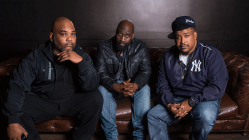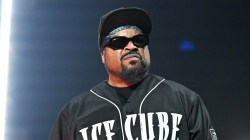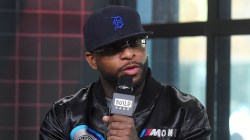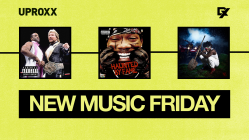Large Professor holds production credits on “Halftime,” “One Time 4 Your Mind” and “It Ain’t Hard To Tell.” For those keeping score, those tracks represent roughly one-third of Nas’ classic debut album, Illmatic. Add in the fact Large Pro included Nas on “Live At The Barbeque”—a Main Source posse cut that showcased Nas to casual fans—introduced him to the likes of Pete Rock and crafted the demo version of “Nas Will Prevail,” and it appears the fellow Queens resident had a heavy hand in making sure Nas created five-mic material. Large Professor sees things a bit differently.
“The beats were cool,” Large Professor said of Illmatic’s all-star cast of producers. “They were good backdrops, but just the lyrics and the experience that he was putting down over those beats just it is why that album is heralded the way it is today.”
Fans would likely beg to differ. But that same modesty can probably be attributed to Large Professor turning down an executive producer credit for his work with Nas. Since working together on Illmatic, Large Professor and Nas have collaborated on Stillmatic (“You’re Da Man,” “Rewind”) and Life Is Good (“Loco-Motive”). The bond puts Large Pro in the unique position of creating material with Nas shortly after high school, at the height of his feud with Jay Z and into late adulthood. As part of HipHopDX’s week-long coverage of the 20-year anniversary of Illmatic, the man who used to chill on the terrace with Nas while listening to Gang Starr provides his unique perspective.
Large Professor Recalls Meeting Nas & Recording The “Illmatic” Demo
DX: With Illmatic approaching its 20th anniversary, when was the very first time you met Nas?
Large Professor: The very first time I met Nas was outside of my school. He was going to record a demo.
DX: What school was that?
Large Professor: John Browne High School. Yeah, I was coming from school, and we had mutual friends. Two dudes; Joe Fatal and MelQuan, and so they kind of enlisted me to do his demo…to do the beat for his demo. He had some studio time; like his mother gave him some cash to a demo or something like that. So he was recording the demo, and we went out to Coney Island. From there we took a cab to Coney Island, and you know it was on. That was pretty far for then.
DX: Absolutely. What studio was that?
Large Professor: Sty in the Sky. I think it was kind of crazy, because he may have even looked that up in the yellow pages. I think he looked that up in the yellow pages, and he was asking like, “Yo, who should I get?” And it was like, “Yo, there’s this guy in Flushing, man. He’ll lace you.” And that’s kind of what we did from there.
DX: You really mean to tell me you took a cab from Flushing all the way to Coney Island to drop that?
Large Professor: Word. We took a cab from Flushing to Coney Island to do the demo. And it’s so ironic because here he is; he’s from Queensbridge, and all of these dudes are getting down—llike Marley is from there and everything. But he looked in the yellow pages to do his thing. That’s crazy.
DX: What did you record that day for his demo?
Large Professor: I don’t remember the name of the song. I remember the record that I used to make the beat. It was a sample that I used from a General Cook record… No, no, it was a Chairman of the Boards loop. And I just remember the rhyme. When I heard him rhyme, the first thing I caught on to was that he was out of the ordinary. He wouldn’t say, “Cat, hat..” he would say something like, “Cat, Arafat.” You know, something like that… And he said some other shit, and that’s when I first caught on to it, like, “Yeah, this is right, right here.”
DX: So, you’re in the studio and he’s doing his Nas thing, he’s a young kid at the time…
Large Professor: We were both. I mean we’re a year apart. I guess I’d experienced so much more by then. But yeah, definitely…we were both young.
DX: You’re both so young, you’re in the studio and you’re both on your way to being masters of your craft if not already. When you guys met, was there a chemistry? Did you know it would be magic?
Large Professor: I did, because I think we both… At that time, if you called yourself a rapper or a Hip Hop artist, you had to be prepared to stick your chest out to the world. So that was kind of the thing at that time; everybody was kind of boasting and kind of sticking their chest out like, “This is who I am.” You know, “Streets disciple / My raps are trifle.” It was kind of like that, going to extreme levels to let the world know who you were. So it was definitely with the intentions of letting the world know who you were.
Large Pro Explains Chemistry Between Nas & The “Illmatic” Producers
DX: Right, so you felt you had a chip on your shoulder at the time?
Large Professor: Nah, it wasn’t a chip on the shoulder. It was just a loud and proudness about it. Then, we were based on skills, and when you felt that you got your skill to a certain point, you felt that you were ready to go out to the world and say, “Yo, this is who I am. I got my skill intact, so check me out.” That’s what Nas said on the fist song; on “Halftime” he says, “Check me out, y’all.” And that’s what that was all about. It was like, “Yo, I’m ready. I’m ready for y’all to hear this, and I think when y’all here this y’all gonna be feeling this.” So yeah, that kind of thing.
DX: Yeah, Nas always said Illmatic was like his application to the Rap gods membership club. Sort of like a “Hear me out..this is what I’m doing…I belong here,” thing.
Large Professor: Definitely, definitely. Yeah, that was it, and with that album, I always say that was a more lyrical-driven album, if anything. Like, the beats were cool. They were good backdrops, but just the lyrics and the experience that he was putting down over those beats just it is why that album is heralded the way it is today.
DX: You’re being really modest, man. Those beats were not just okay.
Large Professor: Nah, I mean, they were bangin’. “One Love,” you know what I mean? “The World Is Yours,” and everything… But you could have had some clown get those beats and put some bullshit down, and them shits, it wouldn’t have been nothing. Nas put something down that was like, “Yo, this is… It’s not the icing on the cake. This is part of the cake.” It was like, “This ain’t the icing on the cake; this is the cake almost,” and the beat was almost like the icing. Nas’s rhymes were like the cake because, you could have gotten any old body to rhyme on them beats, and you would have been like, “That’s cool.” But [with] the stuff like “The World Is Yours,” he was tapping into the spirit of the beats and everything. It was like, “Yo, what is this? This is like world is yours type shit, man,” and that’s serious business.
DX: Absolutely. He’s said in interviews that he begged you to executive produce the album, but you were like, “No. It’s your vision.”
Large Professor: Yeah, nah, like I was on some… We were cool. We would be in the crib, and we’d be recording, and then we’d take a break, sit out on the terrace and just chill. We would be talking about the world like, “Yo, if this planet…” We would just be wandering in thought and just all kind of stuff like that. So, to have that kind of relationship, and then just one day come and say, “Just sign this contract.” Nah, I couldn’t. That’s not who I am. I’m not a sign this contract kind of guy.
DX: There was that camaraderie and that relationship. You even took him up to Pete Rock’s house…
Large Professor: Yes, yes. Yes.
DX: And that’s incredible. In today’s environment I’m not sure producers would kind of put each other on in that way.
Large Professor: Right, right, right. Go to the next producer and bring their break out artist. Yeah.
How Nas’ Session For “Halftime” Came Together
DX: Obviously you made “Halftime” and “One Time For Your Mind.” Did you guys listen to each other’s beats before you made other beats?
Large Professor: Nah, a lot of people think… Nah, everybody worked separately. We were all doing a lot of production anyway. Between myself, Pete, Tip, and even L.E.S., we were all on our production grind hard. So we would get up every now and then, but we were working all the time. So it was just a kind of like, “Yo, aight, this what we’re going to do. This is the song I’m going to do with Nas.” Preem had his song, Nas would play it for me and I’d be like, “Yo, that’s kind of crazy right there. That’s nice.” But then I had to get right back to work. I wasn’t like, “I got to get at Preem on this.” Yeah, it wasn’t nothing like that. It was just like, “Yo, that’s dope. That album is coming together real nice.”
DX: We know you’ve done this before, but could you just take us through the studio session for “Halftime?”
Large Professor: Wow, the studio session for “Halftime.” It was nice, because that was Nas’ first studio session for himself. That was his first session for himself, and he had been recording demos for Eric B. & Rakim and things like that. There was always a feeling of, “We gotta get a certain amount done in a certain time frame.” But, now, with “Halftime,” this was his session. So, there was nothing looming over him like, “Yo, Eric B might come in.” There was none of that anymore. So it was kind of cool. I sort of saw him sitting back. He had his studio… like, just all the weed, all the liquor and his rhyme books. He had his studio pack with him, and his homeboy Bo was there. They were rolling up the oo-wops, and everything was big long blunts and everything. And just… It was just like, “Wow.”
DX: What studio was it?
Large Professor: It was Chung King studios. We were sitting there, and he was sitting back. He was really sitting back on it, and he was just like going through the rhymes saying, “Yeah, a’ight. I’m a put this one down.” And we had all the support there. Everybody was chillin’, and he was like, “Yeah, we’re gonna get em.” That was the spark right there. That was definitely the spark.
DX: When you were making that beat were you thinking about a place in New York City? Did it have that kind of flavor?
Large Professor: Nah. I mean, we just wanted to put something gritty out there to the world, and those drums—that’s what it was at that time. It was that gritty, muffled out, because the Hip Hop that we grew up with… We grew up with park jam tapes and things like the fidelity of these tapes. The frequency was all crazy and muffled, but that was a part of the whole thing to it. It was like, “Yo, this is funky. Yo it’s not all clean and crystal clear. Yo, hear the bass.” You’d hear the bass, [thinking], “There’s too much bass on it, but that’s kind of bumpin’ though. That’s kind of tough right there.” So “Halftime” was kind of like the extension of that right there—just the muffled bass and then the drums. You know the bell was in there, and it was just like, “Yeah. That’s a’ight right there. Word.” We were happy about that.
DX: Yeah, man. It was sinister. How many takes did it take him to lay down his verses?
Large Professor: Oh, it wasn’t long at all, because Nas, he’s one of those rappers… You get some rappers who they had their rhymes. Like, [Big Daddy] Kane was one of them. If you listen to Kane’s album, he kicks the same rhyme twice on that album on two different songs. So you get some rappers who start copying, pasting, cutting and editing rhymes together and stuff like that. He knew the rhymes already, so it was no time, man. We was finished. More than anything, we were just doing a lot more partying and listening like, “Yo, play that shit again! We’re sitting on a big one!” Like, “Yeah we got em!”
DX: So you guys were listening to tracks and you knew they were going to be big?
Large Professor: Yeah, yeah, yeah. We were sitting there like, “Yo, we’re getting ready to get em,” like, “This is gonna be crazy right here!” Yeah, definitely.
DX: And, “One Time 4 Your Mind,” that was the same deal? That was at Chung King as well?
Large Professor: Yeah, that was at Chung King. That was kind of crazy, because I did that beat in the studio. We kind of just vibed out. That was a cool joint, because it was like I was just sitting there… We were all sitting there, just kind of just going through some records and I put it together. He was like, “A’ight, that’s good enough right there.” Then he kind of went in, and that’s why it’s not as concentrated as everything else. It’s just like a cool joint; it’s just like, “Yo, didn’t I send a shorty to the store for Phillies?” He was just taking it light like, “What’s an average day in Queensbridge?” kind of thing.
Large Pro Addresses Nas’ Reputation For Beat Selection
DX: So you guys just knew when to stop and when to push? Was it a feeling?
Large Professor: That’s all him. He kind of had that instinct. He was just like, “Yeah, yo, we’re going to let it rock like that.” And that was it.
DX: He kind of gets a bad rap, because some people think he can’t pick beats. But then you look at the work that he’s involved in and you hear the stories, and it’s not like that at all.
Large Professor: Oh, nah, not at all man. And the thing about it is like it ain’t even about a beat—it’s about a song…a composition. And that’s why people will say, “Yeah, we don’t really love that beat,” or whatever, but they love his song. So that’s the whole thing about it. It’s like, “Yo, at the end of the day, it ain’t about, ‘Oh the rhyme or that beat,’ it’s about the whole composition. [When you say], “Yeah, that right there. That’s that thing right there.” And that’s why he’s still going strong to this day, because he can make a song. He can make compositions. Whole compositions.
DX: But you guys were so in sync. Did the planets just align or was it something that built with your relationship?
Large Professor: Nah, I think that was just the Queens camaraderie and us just being connected by the 7 train. We had a lot of things in common, and we were all Mr. Magic fanatics. Everyone would listen to Mr. Magic on Fridays, so we all knew that’s what we had to talk about, like, “Yo, did you hear the new this or that?” And it would be like, “Yeah, yeah, that shit was a’ight.” Or, like, “What about that new Gang Starr album?” And it would be like, “Yeah, yeah.” I remember one time I went out to Queensbridge. I was chillin’ with them on the hill, and they were playing the Gang Starr album. They were playing “Take Two And Pass,” and I was like, “Yeah, that was a’ight. I like the beat.” And he was like, “What? That’s crazy right there! I love that shit.” So, you know, it would be like that kind of thing. Just in general, Queens dudes can sit there and talk about music all day anyway, and just argue and listen and have all kinds of debates about music. So we were definitely joined by that.
DX: Right, and for “It Ain’t Hard To Tell” that was actually on his demo, right?
Large Professor: That’s right.
DX: And then you guys redid it for the album?
Large Professor: Yup. When we redid it, it was nice because we already knew what we were doing, and it was just like, “Yo, we’re gonna reflip it like this.” He just went in and with that one—the one that actually hit the world that came out. I think he really mulled over it and got it right, man. Because the first one that we did, that was a little rougher and he was a little… I don’t know. The style that he was kickin’ over that one wasn’t as developed as the one that actually came out.
DX: And you were actually in Battery Studios when “The World is Yours” was getting made with Pete Rock?
Large Professor: Yup, I was in Battery…definitely. Him and Wiz—they had just finished—and I rolled by there. They were playing that, and I was like, “Yo, this is insane.” It was just insane. Yeah, definitely, I rolled through there. That was nice. I wasn’t there for the whole session. I just got there at the end, but I was like, “Yeah, that’s tough right there.” We were just listening, and I was just happy.
DX: What was it like to be a part of such an amazing album? You kind of guided Nas through that whole process even though you were going through your own drama at the time with Main Source. Can you talk about what that was like?
Large Professor: Nah, that is beautiful, man. That was like a gift from God. Like you said, I was going through my own drama with the Main Source stuff, and it was like, “Nah, put your energy towards something positive, because there’s still something good going.” And it was just what I needed, because if not, if I would have just been kind of dwelling on that Main Source stuff then who knows? But I had something to keep building on and that was Nas. The Main Source… What got us all there dissolved. But now Nas was taking the lead, and I was still a part of that, so I had something to do. I had something to grab onto that was growing.
Large Pro Calls “Illmatic” One Of The Roots Of Hip Hop
DX: Can you comment on the legacy of Illmatic and what it means for you and the rest of Hip Hop?
Large Professor: Illmatic is… I mean his rhyme style, the beat and everything, it’s just really like a root. It’s like a root. It’s like a root that’s in a tree. It’s one of the roots of the tree of Hip Hop, because a lot of styles came from that. A lot of rhyme styles. He got people thinking outside of the norm. Like, “Jerome’s niece / On her way home from Jones Beach,” and things like that. The stuff that he was rhyming was just crazy, man. But, it’s definitely one of the roots that hold the tree of Hip Hop up strong. It’s one of those roots in the ground that’s keeping that tree standing strong and tall.
DX: So many classic records came out that year, do you think there was something in the air? Could you just feel something building in Hip Hop?
Large Professor: Well, I believe in God. So I just know that God works in mysterious ways like that, and you have to pay attention to those energies when they happen like that. You have to make sure you’re paying attention. And it always happens like that, but you just have to make sure that you’re paying attention and grasp the moment. So, that’s all that was. It’s still happening, even these days, man. A lot of things are lining up, and a lot of energy is just coming together to make a series of things happen that are good. So, that’s just God. That’s how God works.
DX: Q-Tip came out a little bit ago and he played Premo’s version of…
Large Professor: “Represent?”
DX: No, of “Memory Lane.”
Large Professor: Wow, I never heard that one. I heard an alternate version of “Represent.” The beat was a lot more busy, and then they just sort of gangsta’d the beat out. They made the beat a lot more gangsta.
DX: Tip played an alternate version of “Memory Lane,” and it was just so crazy that I have to ask if there are any other alternatives out there that never made the album?
Large Professor: Only “Represent;” that was the only one that I heard. And the beat was a lot busier. They did it right with the change of the beat, definitely.
DX: One more question, man. Why do you think Hip Hop fans are so protective of Illmatic?
Large Professor: Because like I said, it’s a root. It’s one of the roots. It had all of the Hip Hop qualities. When you say Hip Hop, it had all of the Hip Hop qualities like through music; he embodied all of that. Talking about the trains, the projects, drug abuse, drug habits and school. It was like news, and we still come from that. Like Donny Hathaway said, “The world is a ghetto.” So even though people might go out there in the world, make their way and wind up in Hollywood or something like that, it’s going to always be a ghetto. And that’s what Hip Hop comes from. Hip Hop comes from ghetto. So, it’s a staple, man. It’s a lot of information and a lot of rules, on that album that you can listen to, man.
You can listen to that album and kind of get your edge. And just to see him—the cover of him as a child, looking out—and you can see the look in his eyes like. It’s like, “Yo, I’m gonna make it. I’m gonna look at all this around me, and I’m going to make it.” And just to see the back cover of him grown up, chillin’ and just getting ready to be on his way. That was inspiration for a lot of people. You know, that cover had a lot to do with it too. That cover had a lot to do with the draw for that album, because when you saw that you were just like, “Wow, he’s got this little kid picture, and it’s torn. And he looks all like, ‘You know what’s going on out here.’” And then you see the back cover; he’s got the fresh cut, and he survived all that shit, and now he’s here just speaking on it. And that had a lot to do with it too. So that was dope that they kind of put that visual out there to kind of go with it. Like, “Yo, I’m still here and I’m speaking on it, and I’m ready for the world.”










Another Illmatic story:
When Large Pro was making beats for Nas he was farting in the studio. One of his farts is heard on one of the songs on Illmatic
Yooo…i thought I heard that shit b….at the 2:37 mark…
*The name of Large Professor’s school is John BOWNE High School, which is on Main Street in Flushing; he did a track celebrating it called “Bowne” on his album The LP in 2009.
The Alpha & The Omega….
Soundcloud.com/p-ez-2
Why can’t hip hoppers talk normally? Why is it always “I was on some”… why not just talk properly? It’s 2014. You got a computer. Last I checked you weren’t a fucking slave who just got out of the field. How about the big strong black person self-actualizes himself and gets a goddamn education?
the culture is negatively enforcing these fools
OH YEAH RIGHT FUCK IMMA LET A BUNCH OF 1000 YEAR DEAD LATIN SCHOLARS AND WHITE SOCIETY TEACH ME HOW TO TALK!!! HOW ABOUT THIS. SHAKALAKABOOZUULUU!!!! Run away scared man.
well why don’t we all just run around saying and doing retarded shit. it’s because the larger culture won’t allow you to function in it unless you are extremely independent and able to indulge your eccentricities. don’t get butthurt just cause the dominant cultural mores is white-oriented.
Eminem had to dumb himself down to function among blacks. He used pills. Now that he’s sober he is clearly terrified but just trying to maintain diplomacy. His whole accent and personality changed and the young boy just seems shook all the time.
FUCK OUTTA HERE WITH EMINEM!!! YOU’RE PROBABLY 20 CALLING HIM YOUNG BOY. EVEN IF YOU’RE 70 YEARS OLD AND BEEN THRU WARS AND CIVIL RIGHTS AND SHIT YOU STILL AINT SHIT COMPARED TO HIS MANHOOD
It’s true. I’m constantly thinking “Damn I’m surrounded by blacks”. You can see it in my obvious nervous tension.
all of the obvious comments have the same IP address, they were written by one incredibly lonely man. but it was pretty entertaining so we thank you.
hey cmon we are in that 2014ies and THAT MEANS afro-americans can talk like that more then ever. this is said from a caucasian hip hop veteran out of munich germany.
Em is talented but he will never touch Nas’s body of work. What white Em stans don’t understand is lyrics are not always about being technical. Music is something you can feel and not saying I don’t feel Em’s music but Nas has more style and authenticity. Not taking anything from Em because he’s an incredible Mcee but Nas is just better. He just has that thing that you can’t put your finger on.